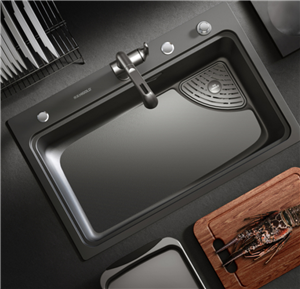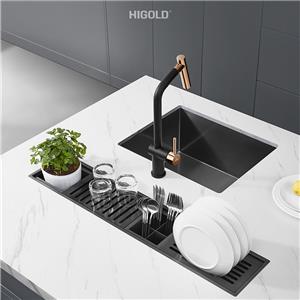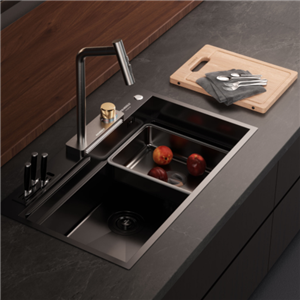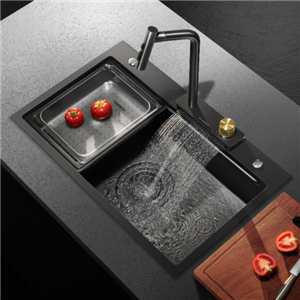Is a single kitchen sink better or a double sink?
In kitchen design, the sink is an important component that cannot be ignored. It not only undertakes daily cleaning work, but is also closely related to the overall functionality, layout, and aesthetics of the kitchen. The choice of sink is an important decision in kitchen decoration, which determines the operating efficiency and comfort of the kitchen. Common kitchen sinks are single and double. Many families are often confused when choosing: Is a single kitchen sink better or a double sink?
Each of these two sinks has its own advantages and disadvantages, suitable for different kitchen needs and family habits. When choosing, it is necessary to comprehensively consider multiple factors such as the kitchen's spatial layout, frequency of use, operating habits, and aesthetic needs. This article will analyze the advantages and disadvantages of single kitchen sinks and double sinks in detail from multiple angles to help consumers make more appropriate choices.
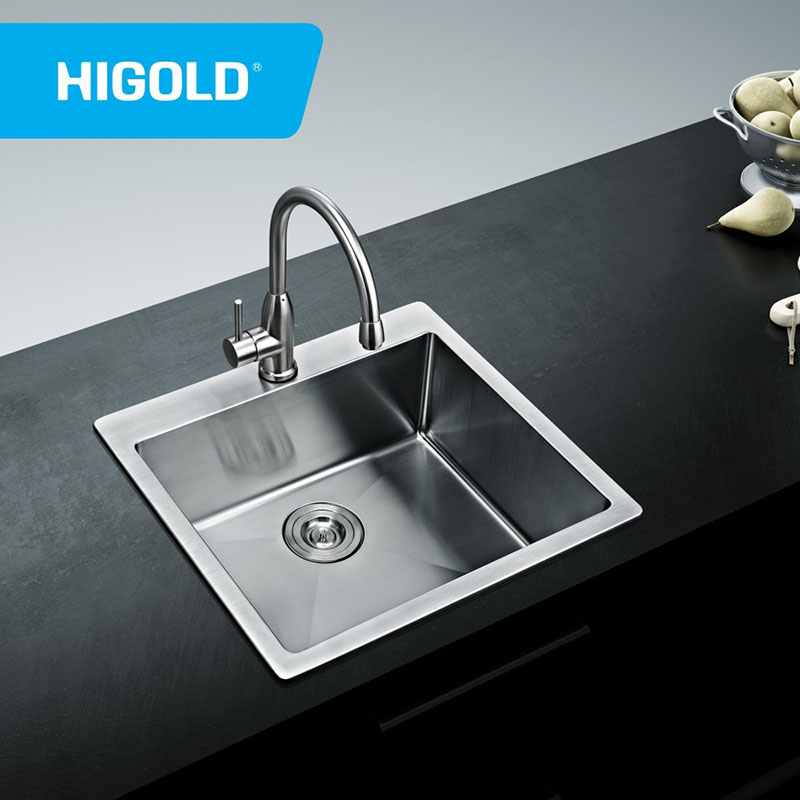
What is a single kitchen sink?
A single kitchen sink refers to a large and deep sink. It is usually composed of a large trough surface, suitable for washing large kitchen items such as pots, bowls, plates, ingredients, etc. Single sinks vary in size and shape. Single sinks on the market can have a variety of designs, but they are usually spacious and deep, suitable for families that need a lot of washing operations.
Advantages of single kitchen sinks:
● Spacious space: Single sinks are usually larger in size and can accommodate more dishes, pots, etc., suitable for washing large kitchen items.
● High flexibility: There is only one sink surface, the operating space is more free, and it can be used flexibly as needed.
● Water saving: When washing a large object, the space in the sink will not be occupied by multiple sinks, and water resources can be used more efficiently.
Disadvantages of single kitchen sinks:
● Unclear division of labor: Since there is only one sink surface, different operations such as washing vegetables, washing dishes, and washing pots may need to be completed on the same sink surface, which may cause cross-contamination or inconvenience in operation.
● Lack of classification function: Compared with double-slot sinks, single sinks lack the function of classification and partitioning when handling different ingredients.
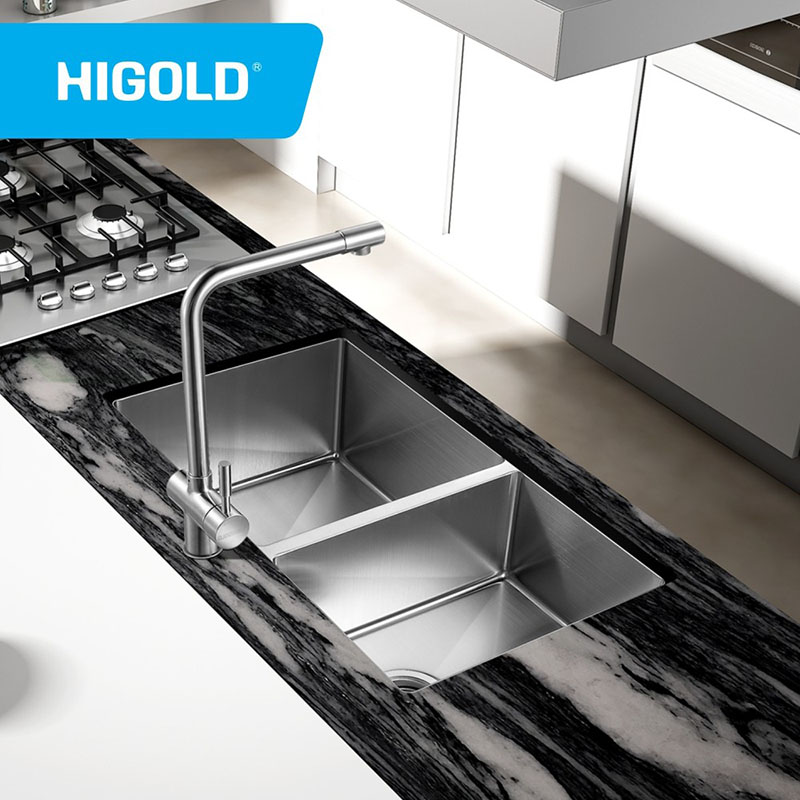
What is a double kitchen sink?
Double kitchen sinks usually consist of two independent sink surfaces with smaller sizes, and each sink surface can be used for different tasks. The double sink design helps to divide the kitchen cleaning tasks, and can distinguish tasks such as washing vegetables, washing dishes, and washing pots to avoid cross contamination.
Advantages of double kitchen sinks:
● Partitioned use: The design of the double sink allows housewives or kitchen staff to assign different tasks to different sink surfaces, such as one side for washing vegetables and one side for washing dishes or pots.
● Improve efficiency: Since two tasks can be performed at the same time, the double sink can improve cleaning efficiency and save time.
● Reduce cross contamination: When washing vegetables, dishes, and pots, it can avoid mutual contamination of ingredients and tableware, especially when handling meat and seafood.
Disadvantages of double kitchen sinks:
● Occupied space: Double sinks usually take up more kitchen countertop space than single sinks, which may be a big problem for families with smaller kitchen space.
● Operational limitations: The space on each sink surface is relatively small, and it may feel not spacious enough when washing large dishes or pots, which limits the flexibility of operation.
● Sink depth: Generally speaking, the depth and capacity of each trough of a double sink are not as good as those of a single sink, so if you need to wash large pots or dishes, you may need to work hard.
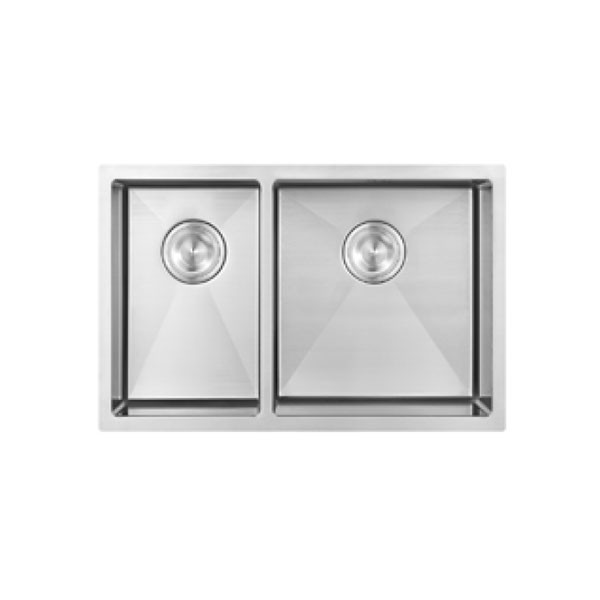
Is it better to choose a single kitchen sink or a double sink?
1. Kitchen space
The size of the kitchen space is an important factor in deciding whether to choose a single sink or a double sink. If the kitchen space is large, then it is usually no problem to choose a double sink, because the installation of a double sink requires more countertop space to accommodate the two trough surfaces, and the operation of a double sink requires a certain amount of countertop space. If the kitchen space is limited, especially in an open kitchen or a small kitchen, a single sink may be a better choice. The single sink has a simple design, takes up little space, and is flexible to use.
Types of kitchens suitable for single sinks:
● Small kitchens: limited space and narrow countertops.
● Narrow and long kitchens: not enough space for a double sink.
● Families with simple sink function requirements: mainly used to wash dishes and dishes.
Types of kitchens suitable for double sinks:
● Large kitchens: enough countertop space to accommodate a double sink.
● Multi-tasking kitchen: multiple cleaning tasks need to be done at the same time, suitable for families who use sinks in different categories.
● Families who need to handle fresh food (such as raw meat and vegetables) independently: avoid cross contamination.
2. Frequency of kitchen use and operation requirements
If there are more family members and the kitchen is used frequently, then double sinks will be more advantageous. When multiple family members work in the kitchen at the same time, double sinks provide higher efficiency and clearer division of labor. For example, one party can wash vegetables in one sink, and the other party can wash pots and dishes in another sink. This not only improves work efficiency, but also avoids cross contamination and keeps food hygienic.
For small families or single apartments where the kitchen is used less frequently and operations are not frequent, the flexibility and space utilization of a single sink may be more suitable. Single sinks are generally suitable for families with fewer people and less frequent use. The cleaning tasks are simpler and more convenient to use.
3. Complexity of cleaning tasks
Double sinks are particularly suitable for families that need to multi-task in parallel, especially when it comes to cleaning multiple ingredients. For example, when handling raw meat, seafood and vegetables, using a double sink can avoid cross contamination. One side is used to wash meat, and the other side is used to wash vegetables or other ingredients. This is essential to ensure kitchen hygiene.
Single sinks are suitable for kitchen environments with simpler tasks. If family members are accustomed to washing items one by one and washing one type of items at a time, a single sink is sufficient to meet the needs and can flexibly handle some large items.
4. Cleaning and maintenance
From the perspective of cleaning and maintenance, single sinks are usually simpler to clean, especially deep sinks, which can avoid water splashing onto the countertop or the gaps around them when washing. In addition, the structure of a single sink is simple, there are not many gaps and dead corners for cleaning, and it is also easier to maintain.
Relatively speaking, cleaning a double sink is a little more troublesome because the number of sinks increases, and cleaning requires more time and energy. At the same time, the joints of the double sink and the gaps separating the sink surface and the countertop are also prone to dirt and dirt, and need to be cleaned regularly.
5. Budget and economic considerations
Single sinks are generally cheaper than double sinks, especially in terms of countertop materials and installation costs. Single sinks are usually cheaper. If the budget is limited, a single sink may be a more economical choice.
Due to the complex design and large space occupied by double sinks, their prices are often higher than single sinks, especially in sinks of some high-end brands and materials, the price difference may be more obvious.

What are the applicable scenarios for single sinks and double sinks?
Based on the above factors, we can summarize some applicable scenarios:
Households or scenarios suitable for choosing single sinks:
● Small kitchens or kitchens with limited space, single sinks occupy small space and are flexible to use.
● The functional requirements for the sink are relatively simple, mainly used for daily dishwashing, and do not involve complex task allocation.
● For families with limited budgets, a single sink can meet basic cleaning needs.
Households or scenarios suitable for choosing double sinks:
● Large kitchens or large families that need to perform multiple kitchen tasks at the same time.
● Families that need to process ingredients in different areas to avoid cross contamination, especially when handling fresh food.
● If the kitchen is used frequently, double sinks can improve efficiency and reduce cleaning waiting time.
Wholesale Kitchen Sinks at Low Prices from Higold
For buyers seeking high-quality kitchen hardware at affordable prices, Higold Group Co., Ltd. is the ideal supplier. We manufacture stainless steel Inox sinks and kitchen faucets with advanced technology, ensuring a perfect balance of price and performance. Our factory produces more than 25,000 sinks monthly, and we offer attractive discounts for large orders. Whether you are a retailer, distributor, or contractor, Higold is your go-to partner for premium kitchen products.

